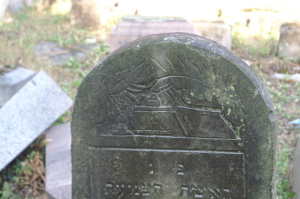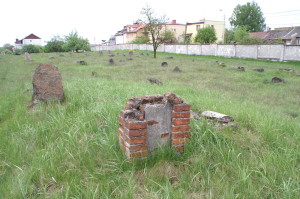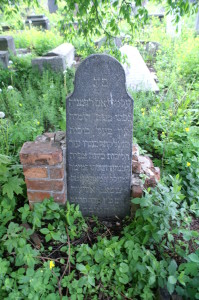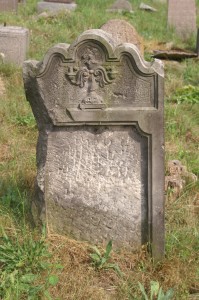Tombstones
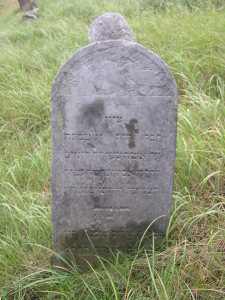
Jewish Tombstone: In biblical Hebrew, the term matzevah “pillar, stone” is frequently used to mark a place of divine appearance, as in Jacob’s dream at Bethel (Gen. 28:18); to mark an agreement between two parties, as between Jacob and Laban (Gen. 31:45); as pillars representing the twelve tribes of Israel (Exodus 24:4); and as sacred stones connected especially with pagan altars condemned by Deuteronomic norms (Deuteronomy 7:5). Only once does the term matzevah “stone, pillar” mark a gravesite, that of Jacob’s beloved wife Rachel (Gen. 35:20). In 2 Samuel 18:18, however, we find the term matzevah used not to mark a gravesite but to bring eternal remembrance for an individual, Absalom, “who had no son to keep [his] name in remembrance.” Another term tziyyon “sign-post, monument” occurs but three times in the Torah, only once to serve as a monument to mark the gravesite of the prophet Elijah (2 Kings 23:17). The use of matzevah in Gen. 35:20 and tziyyon in 2 Kings 23:17 indicate that a gravesite was marked according to the biblical text and, in the case of Absalom, with the additional wish to bring remembrance of the deceased. No mention of an inscription on this marker, however, is indicated. Both these biblical passages, are incorporated into inscriptions at Bagnowka Beth-Olam and in Ashkenazi epitaphs in Eastern Europe in general. That a tombstone serves both to mark a gravesite [kever] and evoke remembrance is seen in the use of both the terms tziyyon and matzevah in the following featured inscription from Bagnowka Beth-Olam:
“A memorial [tziyyon]. This is the grave [kever] and its matzevah over a woman young in days, to the poor and needy she stretched out her palms, the modest and the important (woman), the married Chasha daughter Shalom Shechna Chazan. She died 4 Adar 5663 [3 March 1903]. May her soul be bound in the bond of everlasting life.”
In the Talmud, the term matzevah continued to be used in reference to marking a gravesite, but the term nefesh (lit. soul) was also used to designate the grave marker, as according to ancient Jewish belief the soul would hover over the burial site and the stone would serve as a place for the soul to dwell. Elsewhere, the Talmud (Sanhedrin 48a, Mishnah Shekalim 2:5, Moed Katan 5a) offers support for marking the gravesite, in one passage (Moed Katan 5a) drawing support from the words of the prophet Ezekiel (39:15): “And when travelers pass through the land, anyone who sees a man’s bone shall set up a sign by it.” Yet none of these passages suggest an inscription was engraved on these markers. Some aesthetic elements must have been engraved upon the gravesite marker or perhaps stones were arranged in a pleasing manner. Jewish cemeteries were already recognized as places of beauty in the early Christian centuries, as suggested by references in the Talmud and New Testament, which attest to the early recognition that Jewish “graveyards are better than thy (Nebuchadnezzar’s) palaces” (B.T. Sanhedrin 96b) and “the graves of the righteous” are decorated (Matthew 23:29).
Suggested Readings: Alfred J. Kolatch, “Tombstones.” In Inside Judaism: The Concepts, Customs, and Celebrations of the Jewish People (Jonathan David Publishers, Inc., 2006): 555-56.
Jewish Tombstone: Ashkenazi: In Bagnowka Beth Olam in Bialystok, Poland, the most traditional style of tombstone is a vertical slab with a rounded top, made of sandstone. This is the Ashkenazi tombstone, distinct from the Sephardic horizontal orientation. Since medieval times, the top of the Ashkenazi tombstone was squared; the rounded top, by contrast, is frequently seen in today’s eastern Europe Jewish cemeteries. The matzevah’s rounded top is so frequently associated with Jewish matzevoth that it was replicated even in the wooden makeshift matzevoth of the Ghetto cemetery in Bialystok and in a contemporary memorial in the Jewish cemetery of Korycin, 39 kilometers north of Bialystok, overlooking the border of present day Belarus. The shape also evoked melancholic reminiscence to the Jewish community of their gravesites when replicated, for example, in the ghetto walls in Bialystok and Plaskow – in this case as an act of visual persecution.
The softness of this sandstone permits the execution of exquisite folk symbols as well as exceptional calligraphy for the epitaph. The symbol is typically located in the upper ornamental register, carved in bas-relief to create a two-dimensional appearance. The epigraph is engraved within the inscriptional register below the symbol, set off with a fine line that frequently surrounds the entire epitaph. The symbol can be a simple book, a lion, a candelabrum or a composite image that, at times, seeks to create a panorama that represents, for example, the domain of a woman, as in the featured tombstone. In this tombstone, a forearm and hand drop a coin into the tzedaka (charity) box with a latch, beneath which rests a Siddur (Jewish prayer book), beside which stands a candleholder with a broken candle, symbolic of a life cut short. These symbols are framed on three sides by a curtain, pulled at left as if to allow the visitor a view within a woman’s home and domain. Gentle carver’s strokes create the folds of this curtain.
Compared to the ornate artistry of carved tombstones in Warsaw, for example, the Bagnowka Askhenazi tombstones may pale. However, these tombstones offer us a glimpse into the Jewish folk funerary tradition that prevailed until about 1910 in today’s northeastern Poland. The calligraphic hand of these epitaphs, too, attempts to replicate the orthography of Torah scrolls and prayer books. Thus, in this style of tombstone, we see the traditional world of Eastern European Jewry that prevailed until shortly after the turn of the 20th century. Symbol, calligraphy and the content of the epitaph reflect this traditionalism, although the artistry of certain symbols reflect the accepted presence of folk art within this community.
Suggested Readings: Monika Krajewska, Tribe of Stones. Warsaw: Polish Scientific Publishers Ltd., 1993: 23-37; “Jewish Cemetery: (Okapowa Street)”.
Marcin Wodzinski, “Tombstones.” YIVO Encyclopedia of Jews in Eastern Europe. http://www.yivoencyclopedia.org/article.aspx/Tombstones
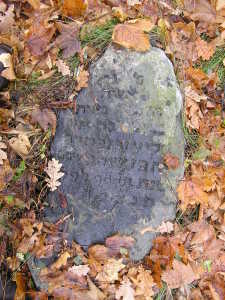
Jewish Tombstone: Boulder: The simple boulder-style matzevah is also found in Bagnowka Beth Olam, but it is far more frequent in such nearby smaller communities as Drohiczyn, Knyszyn, and Narewka. The use of the boulder shape in these communities may be attributed to a local stonecutter, who utilized regional large fieldstones rather than quarried granite or sandstone. It is such field stone matzevoth that the Jewish historian Avraham Shmuel Hershberg wrote of in his Pinkos Bialystok (Bialystok Record Book) as erected by Bialystok Jews in batei-kevuroth (burial grounds), which had been located in cities surrounding Bialystok before Bialystok established its first cemetery, the Old Beth-Olam.
This boulder-style matzevah may be inspired by the biblical verse in Genesis: “So Jacob arose early in the morning and he took the stone (matzevah) that he had put under his head and set it up for a pillar and poured oil on the top of it” (28:18). The choice of using a boulder-style versus cut granite or sandstone tombstone may also be influenced by regional stylistics, availability of materials, or due to economic means, either on the part of the family or due to historical events (such as World War I) that impacted the community’s economic status. It is also possible that this type of tombstone, like the wooden tombstone, may have been a temporary one set in place until the family or community was financially able to erect a more formal one.
Nearly a dozen of these boulder-shaped matzevoth are still found in Bagnowka Beth-Olam today. They are among the oldest matzevoth extant and are located in the oldest sections of the cemetery, near its three entrances. The boulder-style matzevoth at Bagnowka Beth-Olam connect the craft of the stone designer not only with an earlier burial practice but also with cemeteries throughout the Bialystok region, demonstrating the interconnection of the monument artisan(s) in this region.
Suggested Readings: Genesis 28; Avraham Shmuel Hershberg, Pinkos Bialystok, Volume II: 170-172 (in Yiddish), available online at http://yizkor.nypl.org/index.php?id=2887; (for replacement of wooden matzevoth see) Jerzy Woronczak, “The Jewish Cemetery in Biała (Zünz)”. In Jews in Silesia. Edited by Marion Wodzinski and Janusz Spyra. Cracow: Ksiegarnia Akademicka, 2001: 281-288.
Boulder-style tombstones in Bialystok regional cemeteries.
Tombstone: Grotto-Style: Another less common style of tombstone attested at Bagnowka Beth Olam is that of the grotto-like monument, in which a matzevah is enclosed partially in a brick or concrete surround. At present, just two such tombstones are extant. A remnant of the brick surround is found in Section 6, located between the two main entrances on Wschodnia Street. In Section 7, near the western wall, off the main entrance, another with the matzevah intact is preserved, dating to 5659 (c. 1899).
It is possible that this brick once was covered with concrete as suggested by similar monuments found at another regional Jewish cemetery of Dąbrowa Białostocka, 72 kilometers north of Bialystok. At this cemetery and, especially, at Goniądz, 54 kilometers north of Bialystok, the matzevah is completely encased in what is a narrower concrete surround. Where the concrete is breaking away, a hint of the brick substructure is in evidence. In an extant photograph from Bialystok’s Old Beth-Olam, a tombstone likewise suggests this style..
Grotto-style tombstones at Dąbrowa Białostocka.
Grotto-style tombstones at Goniądz.
This grotto-style matzevah may also be a vestige of an older type of small ohel (tent) shaped matzevah recorded in early 20th century photographs from the Lithuanian cities of Vilna, Wilkomierz, and Wylkowyszki. The front façade of the small ohel was grotto-shaped with an attached enclosed tent or house structure that covered the grave. At times, however, this tent structure was quite low to the ground. Thus, this pattern of appearance – Bialystok, Goniadz and on into Lithuania, suggests an affinity amongst stone crafters, with Bialystok (at present) as the southernmost location of this style of matzevah.
Suggested Reading: Tomasz Wisniewski, Nieistniejacw Mniejsze Cmentarze Zydowskie Rekonstrukcja Atlantydy. (The Lost World of Small-Town Jewish Cemeteries.) Kreator: Instytu Wydawniczy, 2009.
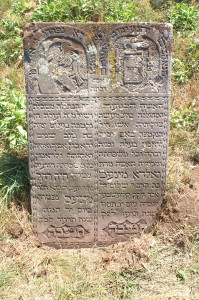
Tombstone: Double Burial: “Beloveds and friends in their lives and in their deaths they will not be divided.” This verse, drawn from II Samuel 1:23, the dirge of King David as he mourned the loss of Saul and Jonathan, is found especially as an upper inscription on double tombstones. A double tombstone or bi-epitaph refers to a tombstone that bears the epitaphs of two individuals, typically close family members such as a husband and wife or mother and daughter. The words of II Samuel 1:23 roll over the parallel ornamental register of a mother and her daughter in this featured epitaph and tombstone. The mother, at right, is remembered with a siddur (prayer book), labelled accordingly as סדור, flanked by two candles, atop which a bird seemingly flutters its wings while plucking at a branch. These symbols represent the domain of a mature Jewish woman, attentive to prayer and to lighting the Sabbath candles, whose life nonetheless is plucked short. The daughter, at left, is remembered with a tree whose branch has been bowed so low it has snapped, emphasizing the devastation of a young life cut short. The mother Golda Mines, died on 24 June 1914; the daughter Chaya Rachel, on the following day, 25 June 1914. The 100-Year Polish Privacy Law, in general, does not permit their death record to be released, however, the date in June is suggestive of casualties caught up in the beginning of World War I. Their joint matzevah with its opening exposition of love, along with individual symbols and epitaphs, forever unites them together in collective memory while acknowledging their individuality:
“Beloveds and friends, in their lives and in their deaths, they will not be divided. A mother and her daughter.”
(Right) “A modest, praiseworthy woman, in the multitude of deeds is her righteousness, a woman of valor, who was plucked in the motherhood of her days, to the languish of her husband and her sons and her daughter and all her family and her friends, the woman, the married Golda Mines, daughter of the rabbi R. Shalom of blessed memory, head of the Beit Din of the holy community of Kleszczele. She died on the 13th day of Tammuz 5674, as the abbreviated era. תנצבה
(Left) “Her unmarried daughter, wise and perfect, compassionate, who was plucked up in the youthfulness of her days, of goodly years, to the languish of her father and her brothers and her sister and to the languish of all her family and acquaintances and friends, Chaya Rachel, daughter of R. Yitzhak Shmuel Halewi, Mines. She died on the 14th Tammuz 5674, as the abbreviated era. תנצבה.”
When considered together, their epitaphs help us recreate their family: Golda was married to R. Yitzhak Shmuel Halevi (noted on Chaya’s epitaph, as a daughter is remembered in accordance with her paternal lineage). Golda was the daughter of a R. Shalom, who is thus the maternal grandfather of Chaya Rochel. Yitzhak and Golda had other sons and another daughter, the siblings of Chaya. Golda’s epitaph, as typical, records the name of her father, a R. Shalom, with the additional detail that he was the head of the Beit Din (legislative court) of Kleszczele, a small town some 60 miles southeast of Bialystok. It is very likely that Golda settled in Bialystok following an arranged marriage. Arranged marriages and economic opportunities were two common reasons for migration to Bialystok at the turn of the 20th century, if not earlier.
Suggested Readings: II Samuel 1; Vital Records Offices in Poland http://www.genoroots.com/eng/article_vro.php For migration patterns to Bialystok in the late 19th – early 20th centuries, see: Heidi M. Szpek, “Jewish epitaphs from Białystok, 1892–1902: embracing the spirit of Dubnow.” East European Jewish Affairs, 42:2 (2012): 129–158.
See also: Epitaph: Death by Fire (Triple Burial).
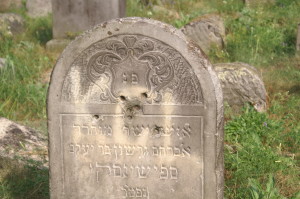
Tombstone: Defacement: Occasionally, a Jewish epitaph indicates death by violence. However, the tombstone itself is also telling of the violence inflicted upon a Jewish community or the memory of a Jewish community. The tombstone of Avraham Spishinski still stands today near the main entrance of Bagnowka Jewish cemetery. The face of his matzevah is riddled with the scars of bullet shots that also mark other matzevoth in this section of the cemetery. It would seem that the shooter used the shield with plumes upon his matzevah as a target. Avraham’s epitaph reads:
“Here lies an upright man, our teacher the rabbi R. Avraham Gershon, son of Yaakov, Spszinski. He died Monday, 16th Sivan year 5665 as the abbreviated era. תנצבה”
Avraham died on 6 June 1905. After five years of economic struggle, 1905 marked an economic upturn for Bialystok’s industrial development. Yet as the city’s economy soared, violence erupted in April 1905 that continued until the June 1906 Pogrom. Anti-Semitic violence took the lives of more than a 100 Jews amidst much destruction of property as well. Three of these times of violence are remembered on the black obelisk and memorial tombstones in Bagnowka, in the Memorial Complex near the center of the cemetery. There is no evidence to suggest that Avraham died as a victim of this violence. His epitaph recalls a world imbued by traditional Jewish learning, a world in which the Talmudic scholar prevailed, a world that would soon change given the growth of the textile industry, Zionism, Bundism,and a host of varied Jewish religious denominations. This diverse and burgeoning Jewish community would be decimated by the Holocaust. Those few Jews who did survive fled the post-War wave of anti-Semitism in 1968. Amidst this decimation, Jewish material culture was also violated, a violation that continues to the present. Avraham’s matzevah bears witness to this violence of material culture. Squinting at his matzevah today, the visitor will also discern the graffiti letters KCI, at present, an unknown acronym.
Near the matzevah of Avraham Spszinki stands the matzevah of a woman whose identity will forever remain a mystery. Not because here epigraph lacks a surname, a not uncommon detail of 20th century epitaphs in Poland, nor because the elements of nature have worn away an inscription carved into a soft stone. Such wearing is also common on matzevoth, especially in northeastern Poland. Rather the epitaph of this matzevah has been chiseled away from its facade, blow by blow. Chisel marks are common within the ornamental register; they create a textured background for a symbol. We see the subtle engraver marks about the exquisite candelabrum of this matzevah beneath which the long angry gashes have permanently effaced her epitaph. The left side of this matzevah has also been shattered away.
Her matzevah does offer some clue to her identity. She was a woman of some means, who died around 1900, inferred by comparison of the unique shape of her matzevah, the date of burials in this section and the exquisite three dimensional crafting of her candelabrum. Her tri-pronged candelabrum also suggest she was a married woman, responsible for the workings of her households and, in particular, the lighting of the Sabbath candles. Death was pre-mature as suggested by the two broken side candles of her candelabrum. While death, hopefully natural, claimed her life, nature did not efface her name forever from memory, hatred long after her death did this.
